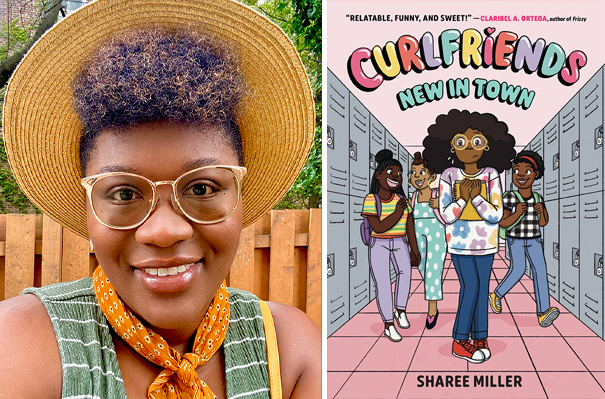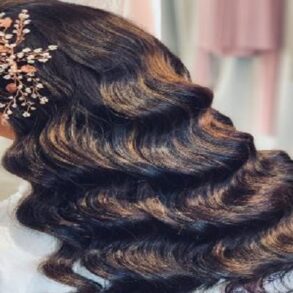
In author-illustrator Sharee Miller’s first middle-grade graphic novel, Curlfriends: New in Town, Charlie, who comes from a military family, has transferred to a new school in the middle of the year. Determined to make friends, Charlie memorizes everything she reads about making and maintaining friendships, even at the cost of hiding her real personality. On her first day of school, Charlie is committed to shedding anything that will make her peers think she’s too immature, such as hiding her love for comics and anime. She meets a group of coily-haired, kind-hearted friends, each with unique personalities, and is willing to do anything to be part of their group, even at the expense of her own happiness. PW spoke with Miller about the importance of seeing Black girls with natural hair in media, making the transition from picture books to graphic novels, and how being uprooted in a military family can lead to people-pleasing traits.
How did you go about creating the characteristics for Charlie?
Charlie is loosely based on me when I was in middle school. I didn’t really want to make an autobiographical book but I still wanted to pull [from] my own experiences. [Like Charlie,] I was aware of feeling like I needed to change to fit in when I was starting middle school. [I felt] anxious when it came to entering groups of friends that were already established. I wanted to work through that in a way for myself but also present it for kids going through that now.
All of the girlfriends have very different personalities. They also have natural but different hair textures. What do you hope readers internalize by seeing that?
I think it’s very important to see [different] hairstyles and these characters represented. Growing up, I felt like I didn’t see myself or my friends represented in this way. A lot of my work centers on natural hair and the acceptance of natural hair. It was something that I was thinking about when I was that age and I continue to think about it. How does your hair represent you as you’re growing up? When I was growing up, a lot of people didn’t wear their hair natural or in its natural state [beyond] elementary school. I was happy that I could show different types of curly, natural hair [types] on girls in middle school who are living their best lives and becoming people others [could] look up to.
Charlie comes off as a people pleaser. Does her being a military child have something to do with that? Do you have first-hand experience with being a military child or have you experienced moving around a lot?
My father was in the military. He had retired by the time I started school, so I didn’t have the experience of moving around, but my sisters did. My mom also grew up in a military family, so I drew a lot from her experiences. I feel like growing up in a military family does lead to a little bit of a people-pleaser mentality because your family ends up being strict even if you have a chill parent like Charlie’s dad and [even] my dad. You still feel this obligation to follow the rules and hold yourself accountable in a certain way. I think [that] it also comes from moving around a lot and feeling the need to get people to like you immediately. You don’t know how long you’ll [live] there and you know that you’re starting from scratch while everyone else has [established] relationships.
How is writing picture books different from graphic novels in your opinion?
Picture books are vastly different. Obviously, it takes a lot more work to make a longer visual story [like a graphic novel]. The writing alone took months and then illustrating took years [as opposed to] picture books. I can complete [a picture book] in a year or six months. [With graphic novels], I like the ability to show a whole universe. With picture books, you’re limited to 32 or 40 pages for [younger] children who have shorter attention spans, so you want to be brief. But with graphic novels, you can tell their stories. You can really get into the universe and the characters and their thoughts and outer experiences with the world. I think it’s a great way to advance your storytelling, especially for older readers who can focus for longer and understand more and are able to grasp more advanced concepts.
What drives you to focus on self-love as it relates to Black children?
I feel like I was writing stories for myself when I first started my journey of making books. It was inspired by my Instagram where I had created a platform called “Coily and Cute.” I was sharing images of illustrations of women and girls with their natural hair. I felt that if I had seen images like these growing up, then I would have felt more encouraged to love my hair, or at least learn more about it. I was [also] really inspired by everyone sharing their journeys online and I wanted to [contribute] in a way that was personal to me and that way was [making] illustrations and books. I wanted to have not only my children but all children [and] all Black kids to be able to see these images. I think the next generation [will have a] better feeling about themselves, especially in this world where people are still being punished for wearing their natural hair or taken out of schools [and in some cases losing their] jobs over it. It’s still important that we continue to have these things that not only encourage young people to embrace their hair but also have a conversation about why it’s important not to regulate our hair in ways that are hurtful to ourselves and our self-esteem.
New in Town (Curlfriends #1) by Sharee Miller. Little, Brown Ink, $24.99 Oct. 10 ISBN 978-0-316-59147-8; $12.99 paper ISBN 978-0-316-59145-4
This post was originally published on this site be sure to check out more of their content.







